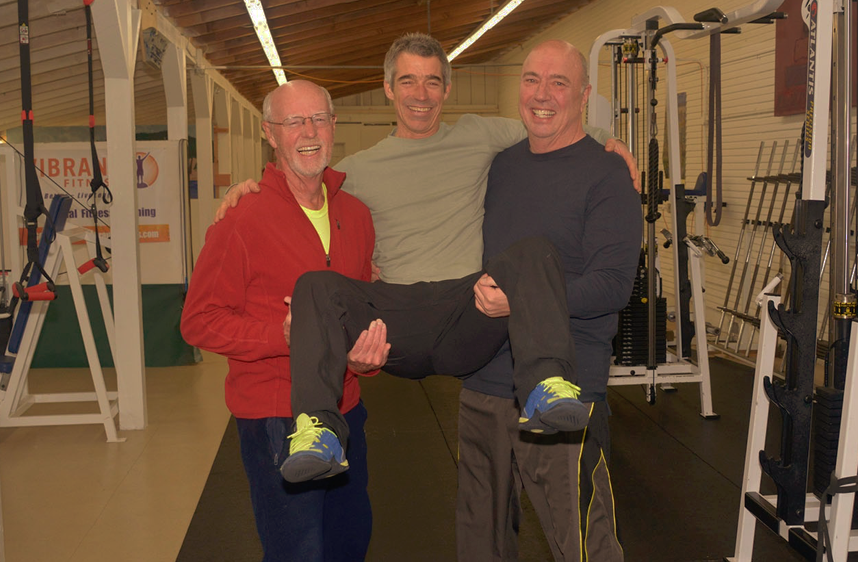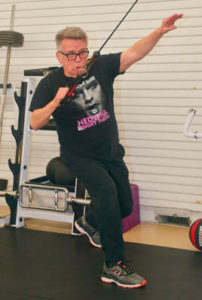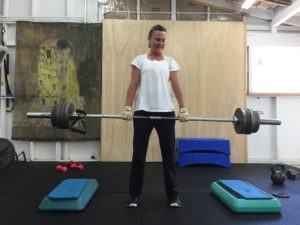
Functional Strength and Movement Training is one of the greatest hobbies/interests/activities that you can add to your life.
The health and wellness benefits it can deliver are objectively true and widely documented. It can also be extremely enjoyable.
This enjoyability is less talked about, and is more subjective of course, but it is something that I am committed to sharing and bringing to more people.
Let’s define the term: Functional Strength Training(FST), then look at what is great and enjoyable about it.

Andy G. At 76, performing a lunge single cable row. Looking good, moving well, and having a good time with FST.
Functional fitness training.
Functional strength training(FST).
For my purposes I will use the longer name: Functional Strength and Movement Training, because my focus is on training movement patterns in the gym that can serve you in your life outside the gym.
Functional Fitness is a popular topic in the fitness space today.
There are many definitions and ideas about what functional fitness or functional strength actually is. (two good definitions from fitness authorities are pasted at the bottom of this post)
To me, FST is a scientifically created western movement art form.
Functional Strength Training is one of the very best things you can do for your health, physical, mental, emotional, and for your quality of life.
It can actually be meditative and enjoyable.
Here are the key points in my view, of FST.
In lay terms, it means you can do the things you do in your ADLs (activities of daily living) with safety and confidence, without hurting yourself.
Consistent Functional Strength Training will have you enjoying these things more, with greater body-awareness and grace, and for a longer time in your life.
This has to include the harder things, such as:
- lifting and carrying heavy objects, such as groceries, tools, children.
– rearranging/moving furniture
– changing light bulbs, getting things off high shelves
- scrubbing the tub, shower, hot tub cover, etc.
– weed eating, vacuuming, shoveling snow (lots of injuries happen here-can you guess why?)
-hiking, walking, crabbing, hunting, golfing, kayaking, cycling, etc.
– gardening(the ultimate functional fitness practice and proving ground!)

Karen C. Deadlifting 115 pounds. “I am stronger now than I have ever been in my life” –at 59 years old!
Relatively few people engage in regular strength training. Estimates are that less than 25% of people between 18-64 meet CDC guidelines of two strength workouts per week. (Forbes Magazine Ref. Here)
So most people have not experienced the numerous benefits that it can bring. The research-supported benefits of strength/resistance training are vast and deep. When the training is Functional Strength Training, they are greater still.
My favorite benefit is feeling strong and confident in my body, in the gym, when I wake up, through the course of my day.
What does that look like?
One of my clients in her 50’s shared this experience, after about nine months of regular FST workouts with me: She has originally come to me quite soft and deconditioned.
“ I had to run to catch the ferry, with my heavy handbag. As I broke from a fast walk into a jog, I felt my core muscles come alive to support my more dynamic motion, I stabilized my right shoulder, as I had practiced in the gym, felt the strength in my arm. I enjoyed feeling my strong legs and glutes as I moved easily up the car ramp. I heard my trainers voice inside say ‘you feel strong, you know who you are’ and I smiled because I really felt it, in my whole body.”
Some good Industry-Authority Definitions of Functional Strength:
The National Academy of Sports Medicine (NASM),
“Traditionally, functional training is considered integrated (total body), multi-planar movement that requires efficient acceleration, deceleration, and stabilization capabilities. It also involves training in a proprioceptively enriched (unstable, yet controllable) environment. The idea is to train ‘movements’ instead of ‘individual muscle groups’.”
(that last line is integral to my training. ~A)
The American Council on Exercise (ACE):
“performing work against resistance in such a manner that the improvements in strength directly enhance the performance of movements so that an individual’s activities of daily living are easier to perform.”
